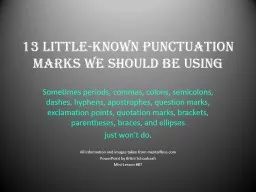

Sometimes periods commas colons semicolons dashes hyphens apostrophes question marks exclamation points quotation marks brackets parentheses braces and ellipses j ust wont do All information and images taken from mentalflosscom ID: 555467
Download Presentation The PPT/PDF document "13 Little-Known Punctuation Marks We Sho..." is the property of its rightful owner. Permission is granted to download and print the materials on this web site for personal, non-commercial use only, and to display it on your personal computer provided you do not modify the materials and that you retain all copyright notices contained in the materials. By downloading content from our website, you accept the terms of this agreement.
Slide1
13 Little-Known Punctuation Marks We Should Be Using
Sometimes periods, commas, colons, semicolons, dashes, hyphens, apostrophes, question marks, exclamation points, quotation marks, brackets, parentheses, braces, and ellipses
j
ust won't do.
All information and images taken from mentalfloss.com
PowerPoint by
Britni
Schoolcraft
Mini-Lesson #87Slide2
Interrobang
You probably already know the
interrobang
, thanks to its excellent moniker and increasing popularity. Though the combination exclamation point and question mark can be replaced by using one of each (You did what!? or You don't like grammar?!), it's fun to see the single glyph getting a little more love lately.Slide3
Percontation Point or Rhetorical Question Mark
The backward question mark was proposed by Henry Denham in 1580 as an end to a rhetorical question, and was used until the early 1600s.
.Slide4
Irony Mark
.
It looks a lot like the
percontation
point, but the irony mark's location is a bit different, as it is smaller, elevated, and precedes a statement to indicate its intent before it is read.
Alcanter
de
Brahm
introduced the idea in the 19th century, and in 1966 French author
Hervé
Bazin
proposed a similar glyph in his book,
Plumons
l’Oiseau
, along with 5 other innovative marks.Slide5
.
Love Point
Among
Bazin's
proposed new punctuation was the love point, made of two question marks, one mirrored, that share a point. The intended use, of course, was to denote a statement of affection or love, as in "Happy anniversary [love point]" or "I have warm
fuzzies
[love point]" If it were easier to type, I think this one might really take off.Slide6
.
Acclamation Point
Bazin
described this mark as "the stylistic representation of those two little flags that float above the tour bus when a president comes to town." Acclamation is a "demonstration of goodwill or welcome," so you could use it to say "I'm so happy to see you [
acclamationpoint
]" or "Viva Las Vegas [
acclamationpoint
]"Slide7
Need to say something with unwavering conviction? End your declaration with the certitude point, another of
Bazin's
designs.
.
Certitude PointSlide8
.
Doubt Point
The doubt point is the opposite of the certitude point, and thus is used to end a sentence with a note of skepticism.Slide9
.
Authority Point
Bazin's
authority point "shades your sentence" with a note of expertise, "like a parasol over a sultan." Likewise, it's also used to indicate an order or advice that should be taken seriously, as it comes from a voice of authority.Slide10
The SarcMark (short for "sarcasm mark") was invented, copyrighted, and trademarked by Paul Sak, and while it hasn't seen widespread use,
Sak
markets it as “[t]he official, easy-to-use punctuation mark to emphasize a sarcastic phrase, sentence or message." After all, half the fun of sarcasm is pointing it out [
SarcMark].! .
SarcMarkSlide11
This mark, like the copyrighted SarcMark, is used to indicate that a sentence should be understood beyond the literal meaning. Unlike the SarcMark
, this one is copyright free and easy to type: it's just a period followed by a tilde.
.
Snark
MarkSlide12
This cool-looking but little-used piece of punctuation used to be the divider between subchapters in books or to indicate minor breaks in a long text. It's almost obsolete, since books typically now use three asterisks in a row to break within chapters (***) or simply skip an extra line. It seems a shame to waste such a great little mark, though. Maybe we should bring this mark one back.
.
AsterismSlide13
Now you can be excited or inquisitive without having to end a sentence! A Canadian patent was filed for these in 1992, but it lapsed in 1995, so use them freely, but not too often.
Exclamation Comma
& Question Comma